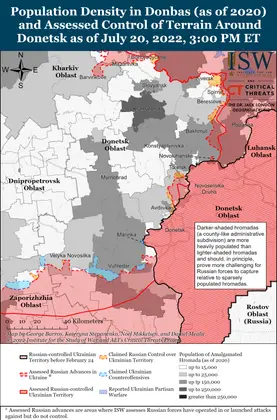Key Takeaways
- The current Russian offensive will likely make marginal territorial gains northeast of the E40 highway in Donetsk before culminating along the E40.
- Russian Foreign Minister Sergey Lavrov said that Russia is pursuing expanded territorial gains in Ukraine beyond Luhansk and Donetsk Oblast, confirming ISW’s assessment that the Kremlin seeks to capture territory beyond Donbas.
- Russian forces resumed limited ground attacks northwest of Slovyansk and around the Donetsk City-Avdiivka area.
- Russian forces continued localized ground assaults east of Siversk and made marginal gains northeast of Bakhmut.
- Ukrainian forces conducted the second consecutive high-precision strike against the Antonivskyi Bridge– a major Russian logistics artery east of Kherson City.
- Russian occupation authorities are likely propagandizing recent Ukrainian high-precision strikes and partisan activity to set conditions for mass deportations of Ukrainian citizens to Russian territory.
The current Russian offensive may secure limited additional territorial gains in Donbas northeast of the E40 highway but will likely culminate before seizing major populated areas such as Slovyansk or Bakhmut.
JOIN US ON TELEGRAM
Follow our coverage of the war on the @Kyivpost_official.
Russian forces have not made significant advances towards Slovyansk or along the Siversk-Bakhmut salient in the past few weeks and are continuing to degrade their own offensive combat power in localized fights for small and relatively unimportant settlements throughout Donetsk Oblast. Russian troops have notably been attempting to take Siversk since the capture of Lysychansk and the Luhansk Oblast border on July 3 and have still not reached the city as of July 20. Similarly, Russian troops have failed to launch direct assaults on Bakhmut and have largely impaled themselves on fights for small settlements to its east and south. Efforts to advance on Slovyansk have mostly ground to a halt and have made no meaningful gains for weeks. The renewal of active ground offensives following the brief operational pause has not yet translated into meaningful Russian forward progress, although it is possible that either steady Russian pressure or the completion of Russian efforts to rebuild combat power could generate limited gains in the coming days or weeks.
Russian troops are now struggling to move across relatively sparsely-settled and open terrain. They will encounter terrain much more conducive to the Ukrainian defenders the closer they get to the E40 around Slovyansk and Bakhmut due to the increasing population density and built-up nature of these areas (see map in-line with text). The current Russian offensive in Donbas is therefore highly likely to culminate somewhere along the E40 in the coming weeks.

Trump Makes 90 Day Foreign Aid Freeze – Ukraine Military Support Supposedly Untouched
Russian Foreign Minister Sergey Lavrov articulated expanded geographical aims for Russian operations in Ukraine on July 20, confirming ISW’s long-held assessment that Russia has territorial goals beyond Donetsk and Luhansk Oblasts.
Lavrov held an interview with state-owned media outlet RT’s editor-in-chief Margarita Simonyan wherein he stated that the geography of the “special operation” has changed since March and now includes not just the Luhansk and Donetsk People’s Republics, but also Kherson and Zaporizhzhia Oblasts and a number of other unspecified territories. Lavrov also warned that these goals will expand if the West continues to provide Ukraine with long-range weapons. Lavrov’s calls for maximalist territorial objectives are notably divorced from the slow and grinding reality of recent Russian operations in Ukraine as discussed above. Ukrainian counteroffensive pressure is complicating Russian efforts to consolidate military control of occupied Kherson and Zaporizhzhia Oblasts, and it is unclear how the Kremlin will generate the offensive combat power needed to take significant new amounts of Ukrainian territory.
The Russian Defense Ministry publicly identified Lieutenant General Andrey Sychevoy as the commander of the Western force grouping in Ukraine on July 20.
The Russian force groupings in Ukraine appear to follow the structure of established Russian military districts. Ukraine’s Conflict Intelligence Team (CIT) had previously reported that Sychevoy replaced Commander Alexander Zhuravlev as the Western Military District Commander. Russian Defense Minister Sergey Shoigu instructed Sychevoy to focus on destroying Ukrainian UAVs operating near the Ukraine-Russia border, indicating that the Western force grouping is likely operating on the Kharkiv City Axis. Russian forces have thus apparently split Kharkiv Oblast into two axes: the Western force grouping operating towards Kharkiv City and the Eastern force grouping operating in the Izyum-Slovyansk direction.
The Russians have identified commanders of the southern, central, and eastern groups of forces, corresponding to their respective military districts and oriented on Bakhmut, the Izyum area, and Siversk respectively. They have notably failed to identify any commander of Russian forces operating in occupied southern Ukraine, however. The Russian commander of forces on the Southern Axis could be the commander of the Russian 7th Guards Mountain Airborne (VDV) Division based in Novorossiysk, Krasnodar Krai, or of the Black Sea Fleet’s 22nd Army Corps, based in Simferopol, Crimea, respectively, as there is no other obvious military district from which he might be drawn.
Ukrainian troops rescued a cat during clearing operations on Snake Island and evacuated it back to the Ukrainian mainland on July 20.
The cat reportedly survived the duration of the Russian occupation of the island.
Authors: Karolina Hird, George Barros, Grace Mappes, and Frederick W. Kagan
Read the full report here.
You can also highlight the text and press Ctrl + Enter










